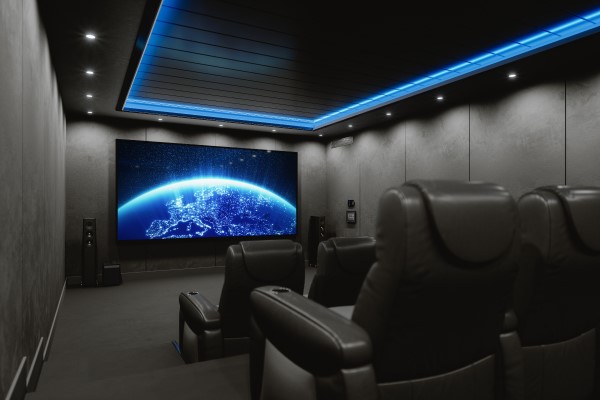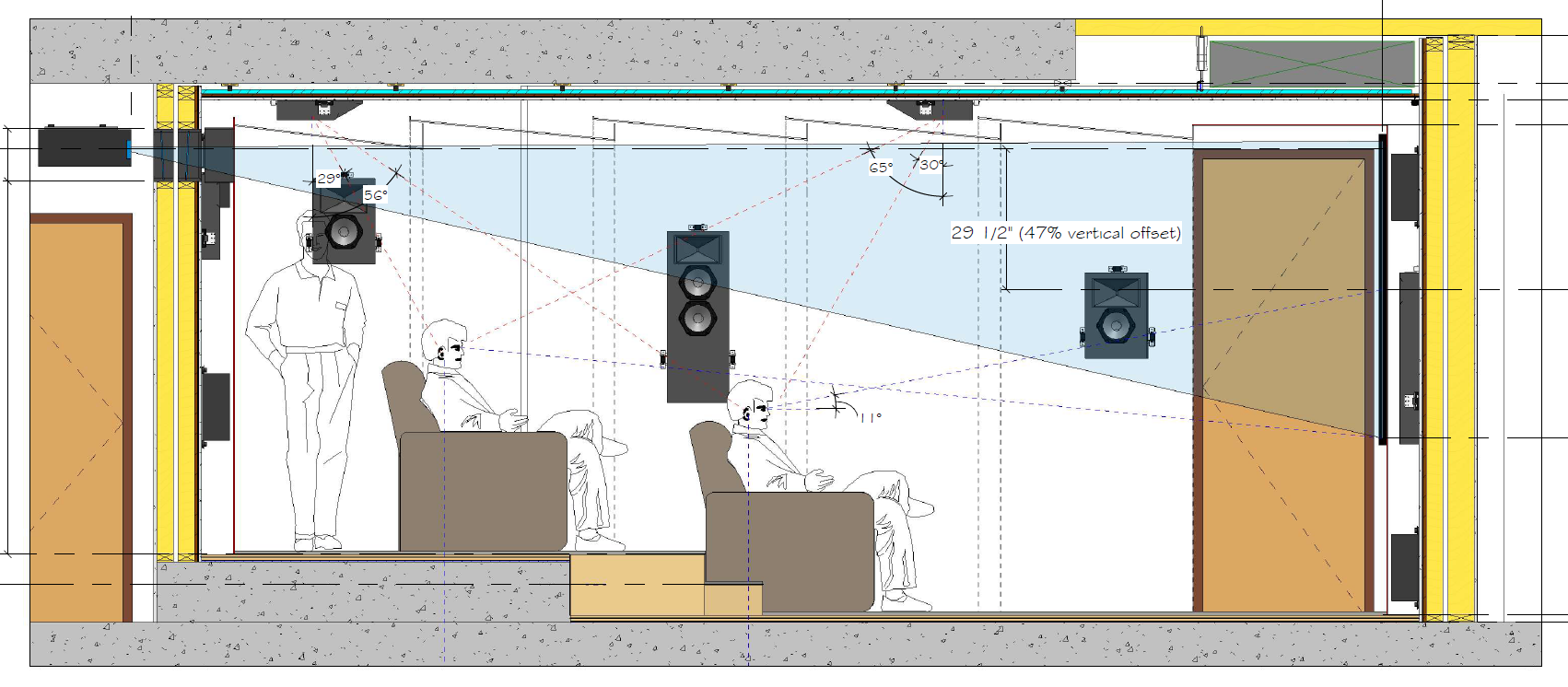Shower the people
Speaker placement can make or break a high-fidelity or cinema installation. Anthony Grimani looks at a method to ensure everything sounds as it should.
In our business, it’s all too common for sound system setup and placement to be “sloppy”.
ADVERTISEMENT
Nowhere is this more evident than with home cinema systems. I’m ashamed to admit the number of times I’ve seen systems where the centre speaker is just sitting on top of the left speaker, the surround speakers are up front buried inside cabinets, speakers are aimed in completely the wrong direction or some equally ridiculous nonsense.
I get the impression some people feel that as long as the speakers are in the room somewhere and hooked up to an output on the AVR, their mission is accomplished and their responsibility fulfilled.
Immersive audio has given us a new outlet for this type of shenanigans with the implementation of top speakers (I’m going to call them ‘top’ because Dolby is the most popular immersive format at present, and they use top. If you’re doing DTS, IMAX or Auro format, please interpolate what I’m saying to their specific terminology).
The idea seems to be proliferating that top speakers are somehow similar in nature to distributed audio speakers that we’ve been installing all around houses for decades now. Ergo, the same speaker models can be used and installed in the same manner. Dolby, along with some equipment manufacturers, are helping this idea by producing diagrams that appear to show exactly that. If you’re caught up in this, I don’t blame you; it’s easy to get swept away. But let’s try to grab onto a branch and pull ourselves out of the river before we go over a waterfall.
Newsflash. Those diagrams are for a consumer, most likely an enthusiast, who has a couch and an AVR and wants to get some speakers to put around the room. If that’s the level of system you’re doing as a professional, then you need to get a new business model. Really. And, sorry.
There needs to be a little more engineering process, so I’m going to give you a nudge out the door by breaking down the three most common types of top speakers and their applications. First is what I’ll call the shower type: a downward-firing speaker that “showers” sound down at the floor below it. Included in this category are speakers with separate tweeters and speakers with coaxial mounted tweeters. This is the type commonly shown in diagrams and, as long as you follow the rest of the diagram, too, and have only one seat or maybe a sofa with several seats on the same row, then a well-engineered shower-type speaker can be made to work.
The second variety is the angled-baffle type: the drivers are typically recessed and placed at an angle of between 20° and 45° so that they don’t just fire straight down; the entire radiation pattern of the speaker can be aimed to cover, for example, several rows of seats. The third variety is sometimes referred to as a diffuse-field speaker. I’ll explain what that is in a moment.
Top speakers present a new challenge to home cinema, because they need to evenly cover a wide area (a few rows of seats) from a closer distance than any other speaker in the system. A front speaker, for example, might need about +/-25° of coverage horizontally and only +/-10° vertically in order to reach all the seats. For a Top speaker, those numbers are closer to +/-45°. Think about that for a minute. That’s almost twice as much dispersion!
Take a look at Figure 1, which shows a typical dedicated home cinema design with two rows and two pairs of top speakers. You can see that the angle of the Top front speakers to the front row is 30°, while the angle to the back row is 65° (average 45°). Top rear is similar: 29° to the back row and 56° to the front. I challenge you to present me with a shower-type speaker that has even coverage from 30° out to 65°. Instead, the listener at 30° will get a fairly decent mid and high balance and smooth response, but the listener way back at 65° is likely going to face significantly shelved-down highs and a dip in the frequency response due to the crossover between the woofer and tweeter. Because the two rows are getting different sounds, you can’t fix it with EQ. You make the front row correct, and the back row is wrong. You make the back row correct and the front row is wrong. The two will never meet.
Enter the angled-baffle speaker, which allows you to tilt the axis of the speaker – presumably by about 45° – to get an average between the rows. Now they’ll both be similar and you can equalise one way that fits all. This is conceptually an improvement; it can be an improvement in reality as well if the speakers are properly engineered. Unfortunately, some angled-baffle speakers – especially those at the more affordable end of the spectrum – run into acoustical issues caused by the structure around the drivers being a concave recess. It’s like a little mini-reflection chamber up there. If you are looking for an angled-baffle type, you should check out designs from Paradigm, Triad or the novel approach we use at Grimani Systems, in which the mids and highs are in a waveguide angled and aimed to cover many rows, while the woofer is flat, small enough and crossed over low enough that the dispersion remains consistently wide out to the angle covered by the mid/hi waveguide. There are also other models on the market and I state these as examples of the angled baffle designs.
What we really need is something that “fires” straight down for simplicity of implementation yet has an unusually (or impossibly) wide dispersion. That animal does exist as what is sometimes called a distributed mode diffused field speaker. What is that? Well, we used to know them as hidden or invisible speakers. Yes, the type that is recessed into Gypsum board ceilings and coated with about 2mm of plaster… True that in the early days, they were really bad. Anyone serious about sound avoided them. So, how can they all of a sudden be a solution?
For starters, the products themselves have gotten a lot better. Newer designs like the ones from Sonance, Amina or Stealth Acoustics are quite competent and we have used them to great effect. Coupled with DSP EQ or “room correction” which has become a lot more prevalent, these hidden acoustic transducer devices do require EQ. However, you can’t really argue that as a deficiency of this speaker type, because all speakers need EQ in a home cinema room – some maybe just a little more than others! I know, I’m just throwing that out there, but it’s true – and a topic for another time.
What makes diffused field speakers a good solution for top, specifically? They, function with a number of actuators pushing and pulling on the gypsum board of the ceiling (yes, you do need timber or metal framed construction for these to work). The effect is kind of like a bunch of little speakers that create such a comb-filtered mess that it all evens out into a scattered wave with extremely broad and even coverage – which is just what we need. The slightly lower SPL requirements for Top channels also contribute to helping out in an area where diffused field speakers are typically weak: output level. That being said, take their bass extension claims with a grain of salt. You’ll need to cross these speakers over to the system subwoofers at a sufficiently high frequency.
There you have it. Shower types can be okay top speakers for simple single seat or single row systems, which are on the lower end of the integration business. Angled-baffle speakers do better at covering multiple rows, which is our bread and butter but can be hit-or-miss with the design.
Diffused field speakers offer a nice alternative that is completely hidden, yet offers sufficient coverage for all the rows. Whatever you choose as the right product for a system, please, be sure to follow best practices when installing and setting it up. Don’t just put it in the room and hook it up. That makes everybody look bad and – maybe even worse – it’s just a waste of resources.
-
ADVERTISEMENT
-
ADVERTISEMENT
-
ADVERTISEMENT
-
ADVERTISEMENT


